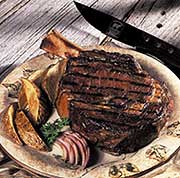Mastering Marinades

By Edward Harazak
From Food Product Design Magazine
Table of Contents
The makings of a marinade
Marinade ways and means
Special flavor delivery

Marinades are popularly defined as seasoned liquids in which meat, seafood or vegetables are soaked to provide flavor and/or tenderization. Depending on the desired end result, marinades can be oil-based to help retain moisture, acid-based to help break down or tenderize the product, or a combination of the two.
Marinades can be made with any number of flavor-providing herbs and spices. When choosing seasonings, always keep in mind the desired flavor impact. A mild-flavored scallop, for example, might not be the best candidate for highly flavored, hearty marinade ingredients, unless the aim is to entirely obliterate the scallop's flavor.
In the past, marinades were generally made from materials at hand. Meats and vegetables were seasoned, then covered with oil and/or a liquid such as wine or vinegar. In time, these methods evolved to produce the mixtures we now know as marinades. Some mixtures are used for as little as 15 minutes for flavoring, while others work their magic for as long as a week. For meat tenderization, six to 12 hours is standard.
Marinades, as with all food products, are often culturally and regionally unique. In Germany, for example, sauerbraten is made by marinating beef roast in a sweet-and-sour marinade for two to three days. In the Caribbean, chiles and various spices are added to fruit juice to make a jerk marinade. In Latin America, raw fish is marinated in lime juice and served raw for ceviche. Tandoori spices are used as a marinade in Indian cooking, while Japanese cooking makes frequent use of the soy sauce, sake, sugar, ginger and seasoning mixture known as teriyaki.
The makings of a marinade
When it comes to marinades, just about any medium or ingredient can be used. Chefs, especially, think everything is a marinade - soft drinks, beer, fruit juice, wines of all kinds, vegetable juices, flavored or infused oils, and even dairy products such as milk and yogurt. All these products, when mixed with herbs and exotic spices, can be combined to produce a signature flavor.
When designing a marinade, start with a vision for the intended end flavor. Keep in mind that many companies are looking for what they think "middle America" wants - but middle America is changing. Chain restaurants and grocery stores want to attract new customers, as well as tempt established customers with specialty food products, and marinades can help do this. Enter the food scientist and chef; i.e., culinologist.
From a culinologist's point of view, a marinade first and foremost enhances the flavor of a meat or vegetable. It can also add color, and often tenderizes and sometimes helps preserve the product. The amount of marinade used is determined by the variety of meat or vegetable product used as well as the size, shape and weight and the desired end flavor and cooking system.
Marinade ways and means
Marinating should always be done at refrigeration temperatures. Marinades can be applied in a static state (immersion), but can also be worked into a product via vacuum tumbling, vacuum packaging or injections. This usually creates a more uniform product consistency. Static or immersion marinades are used where a slow-cooked, controlled flavoring is desired. Restaurant chefs will usually marinate products in-house.
Vacuum tumbling and injections are typically done at the processor level. To inject a marinade, needles or probes are inserted and the liquid is injected as the probe or needles are withdrawn, spreading the marinade throughout the entire piece. If seasonings are used, they must be small enough to pass through the needles. Oleoresins and essential oils plated on dextrose or maltodextrin are preferred for injection marinades. The marinade shouldn't contain highly colored ingredients, because colored liquids will leave unattractive "tracks" in the meat.
Oils in marinades help infuse and seal in flavor, and provide a more moist finished product. Acids infuse flavors as well, but also tenderize tougher meats. The higher the acid content, the faster the fibers will break down and allow the meat to cure. Dried or fresh herbs can be used, or added as essential oils or oleoresins. Garlic cloves and onions (raw, roasted or caramelized) achieve a more dynamic flavor. Keep in mind, however, especially with raw juices, vegetables and herbs, that you don't want to whip up a microbial hazard - don't forget about HACCP requirements.
Enzymes such as papain speed tenderization of tougher cuts of meat. Enzymes are used at no more than 0.05% of the formula by weight. The best way to stop continued tissue breakdown is to first sear the meat, then cook in the desired manner to a minimum of 140°F, at which temperature enzymatic action ceases.
Marinades designed for frozen applications must contain a higher level of solids to prevent cell damage to the marinated products. A freeze/thaw-stable starch can provide solids and help the product weather the elements. Commercial marinades might also contain phosphates to help retain moisture.
Special flavor delivery
Beyond the basics, there's a veritable cornucopia of ingredients that can give a marinated product a special character. Various wines such as Chianti, Madeira and port lend special attributes to sweet and savory marinades. Colas and citrus-flavored soft drink syrups make a perfect marinade for barbecued and roasted meats. With their high sugar content, they tend to caramelize and add a unique color, as well as a flavor that people often recognize but can't quite place. Heavily sweetened marinades such as those made with honey or excessive amounts of sugar should be cooked at a slow temperature, preferably covered to start, and then finished at higher temperatures to glaze and brown if needed.
Varietal honeys, including orange blossom, avocado and wildflower versions, as well as specialty mustards such as tarragon-and-honey, lime-and-chipotle and beer-flavored varieties, bring a unique profile to marinades. Additionally, think of the liquor bar as a complete chemistry set of flavors. Rum, flavored liqueurs, whiskey, bourbon and sake are just some of alcohol-based marinades possible.
Dairy products bring creamy notes to marinades, and buttermilk, sour cream and yogurt can also produce an acidic tang. However, marinades with dairy products are difficult to keep shelf-stable. The best way to use dairy products is to add them just before beginning the marinating process.
Don't dismiss ketchup as a marinade ingredient. There's more than just the tomato variety - hazelnut, walnut, papaya and mango-and-lime ketchups are also available.
Marinades with grill flavors are more popular than ever. Hickory, mesquite, apple, cherry and "straight" grill notes are available from flavor companies and specialty smoke houses. When used correctly, these bring an unmistakable flavor to meats and vegetables. However, they should be used sparingly to prevent "smoke overload."
Chile peppers can be added roasted or smoked to a marinade, or raw for a green, ripe flavor. Chipotle, jalapeño, habanero and ancho notes are familiar to today's diners, and Thai red and green peppers, serranos, tepins and fresh poblanos give even more authenticity. However, make certain you don't scare away the customer by giving them more "spicy hot" product than they can handle.
For a tropical marinade, try using baked banana leaves mixed with pineapple, peppers, coconut and island spices.
The foods of India and Pakistan are becoming increasingly popular in this country. The tandoor oven cooks with a searing heat that is difficult to duplicate by any other means. It necessitates marinades rich in the herbs and spices of that region, such as cardamom, ginger, turmeric and chiles.
Asian profiles come to a marinade via ingredients such as lemongrass, ginger, galangal root, pandan leaves and tamarind. Asian-inspired flavors should be smooth and not overbearing. Soy oil is probably the most common oil used, but toasted sesame oil can also be used sparingly to give a richness to the marinade. Peanut oil can also contribute a great flavor, but consider that for some consumers this ingredient may be an allergen.
What does it take to master marinades? A bevy of good flavors, a little experimentation, and a lot of imagination. Anything you can eat or drink provides possibility for a marinade. If it tastes good, the chances are excellent there's a marinade waiting to be made.
Edward Harazak is executive chef, product development, at International Food Solutions in Milwaukee, a position he has held since 1993. He is a member of the American Culinary Federation, the Institute of Food Technologists, and the Research Chefs Association. In his over 30 years in the hotel and restaurant industry, he has worked for Red Lion Inns, Sheraton Hotels, Drury Lane and Good Earth restaurants, among others. He is a graduate of Stanford University, with a degree in organic chemistry. His hobbies include photography, eating, computers and mystery novels.
• Photo: Certified Angus Beef Program
© by Weeks Publishing Company
Used with permission from Food Product Design Magazine
Weeks Publishing Company
3400 Dundee Rd. Suite #100
Northbrook, IL 60062
Phone: 847-559-0385
Fax: 847-559-0389
